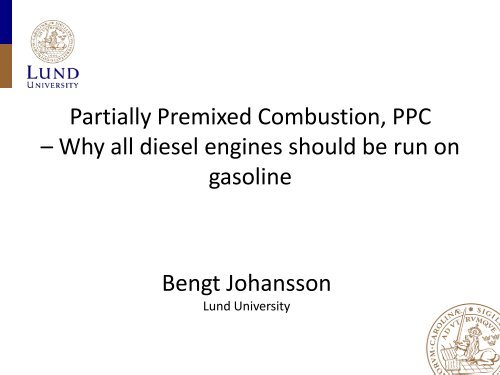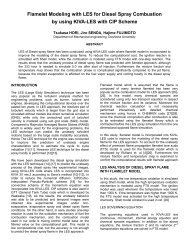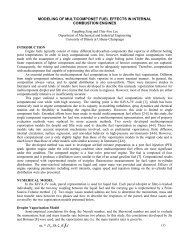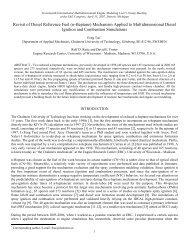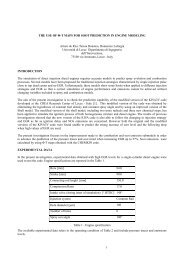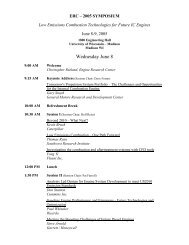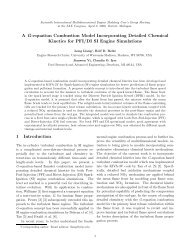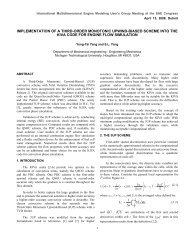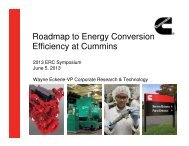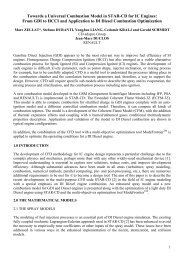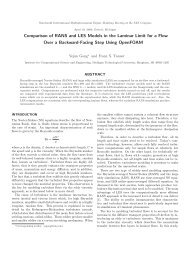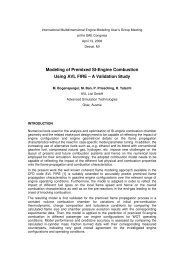Partially Premixed Combustion, PPC â Why all diesel engines ...
Partially Premixed Combustion, PPC â Why all diesel engines ...
Partially Premixed Combustion, PPC â Why all diesel engines ...
Create successful ePaper yourself
Turn your PDF publications into a flip-book with our unique Google optimized e-Paper software.
<strong>Parti<strong>all</strong>y</strong> <strong>Premixed</strong> <strong>Combustion</strong>, <strong>PPC</strong><br />
– <strong>Why</strong> <strong>all</strong> <strong>diesel</strong> <strong>engines</strong> should be run on<br />
gasoline<br />
Bengt Johansson<br />
Lund University
First a little statement:<br />
Dual fuel is not needed!<br />
And 100.000 <strong>diesel</strong> cars per year are<br />
filled up with the wrong fuel in UK. Can<br />
we expect an average US car owner to<br />
put two correct fuels in two tanks?
But I still think a single<br />
fuel is enough…
Gross Indicated Efficiency [%]<br />
Scania <strong>diesel</strong> engine running on gasoline<br />
Group 3, 1300 [rpm]<br />
60<br />
55<br />
!<br />
η i =57% 147 g/kWh (@43 MJ/kg heating value)<br />
50<br />
45<br />
40<br />
FR47333CVX<br />
FR47334CVX<br />
FR47336CVX<br />
35<br />
30<br />
25<br />
20<br />
0 2 4 6 8 10 12 14<br />
Gross IMEP [bar]<br />
4
Outline<br />
• <strong>Combustion</strong> concepts<br />
• <strong>PPC</strong> – background<br />
• <strong>PPC</strong> with <strong>diesel</strong> fuel<br />
• <strong>PPC</strong> with gasoline<br />
• Low dilution <strong>PPC</strong> with ethanol<br />
• Too low load with too high octane number<br />
• Summary
Outline<br />
• <strong>Combustion</strong> concepts<br />
• <strong>PPC</strong> – background<br />
• <strong>PPC</strong> with <strong>diesel</strong> fuel<br />
• <strong>PPC</strong> with gasoline<br />
• Low dilution <strong>PPC</strong> with ethanol<br />
• Too low load with too high octane number<br />
• Summary
+ Clean with 3-way<br />
Catalyst<br />
- Poor low & part load<br />
efficiency<br />
Background<br />
<strong>Combustion</strong> concepts<br />
+ High efficiency<br />
- Emissions of NO x and<br />
soot<br />
Spark Ignition (SI)<br />
engine (Gasoline, Otto)<br />
Compression Ignition<br />
(CI) engine (Diesel)<br />
+ High efficiency<br />
Homogeneous Charge -<strong>Combustion</strong> control<br />
+ Ultra low NO Compression Ignition<br />
x -Power density<br />
(HCCI)<br />
Spark Assisted<br />
Compression Ignition<br />
(SACI)<br />
Gasoline HCCI<br />
+ Injection controlled<br />
- Less emissions<br />
advantage<br />
<strong>Parti<strong>all</strong>y</strong> premixed<br />
combustion (<strong>PPC</strong>)<br />
Diesel HCCI
Outline<br />
• <strong>Combustion</strong> concepts<br />
• <strong>PPC</strong> – background<br />
• <strong>PPC</strong> with <strong>diesel</strong> fuel<br />
• <strong>PPC</strong> with gasoline<br />
• Low dilution <strong>PPC</strong> with ethanol<br />
• Too low load with too high octane number<br />
• Summary
<strong>Parti<strong>all</strong>y</strong> <strong>Premixed</strong> <strong>Combustion</strong>, <strong>PPC</strong><br />
HC [ppm]<br />
NOx [ppm]<br />
Spridare 8x0.12x90 & 8x0.12x150, Iso-oktan, CR-tryck 750 bar, Duration 0,6 ms = 3.6 CAD<br />
6000<br />
1200<br />
HCCI<br />
PCCI<br />
CI<br />
5000<br />
<strong>PPC</strong><br />
1000<br />
4000<br />
800<br />
3000<br />
600<br />
2000<br />
400<br />
1000<br />
200<br />
-180 -160 -140 -120 -100 -80 -60 -40 -20<br />
SOI [ATDC]<br />
Def: region between truly homogeneous combustion, HCCI,<br />
and diffusion controlled combustion, <strong>diesel</strong><br />
SAE 2004-01-2990<br />
9
Outline<br />
• <strong>Combustion</strong> concepts<br />
• <strong>PPC</strong> – background<br />
• <strong>PPC</strong> with <strong>diesel</strong> fuel<br />
• <strong>PPC</strong> with gasoline<br />
• Low dilution <strong>PPC</strong> with ethanol<br />
• Too low load with too high octane number<br />
• Summary
2006-01-3412<br />
Characterization of <strong>Parti<strong>all</strong>y</strong> <strong>Premixed</strong><br />
<strong>Combustion</strong> (<strong>PPC</strong>)<br />
Christof Noehre, Magnus Andersson, Bengt Johansson and<br />
Anders Hultqvist<br />
<strong>PPC</strong> with Diesel Fuel!
Experimental setup<br />
Specifications of single cylinder engine:<br />
Displacement Volume 1951 cm³<br />
Swirl Ratio (standard) 1.7<br />
Swirl Ratio (if modified) 2.9<br />
Fuel<br />
Swedish MK 1 Diesel, CN51<br />
Injector holes 8<br />
Injector hole diameter 0.18 mm<br />
Spray umbrella angle 120<br />
Compression ratios<br />
A=12.4:1; B=14.3:1; C=17.1:1<br />
SAE 2006-01-3412<br />
12
Emissions at 8 bar IMEP<br />
Load<br />
Abs. Inlet Pressure<br />
Engine Speed<br />
Swirl Ratio 1.7<br />
Compression Ratio<br />
Inlet temp without<br />
EGR<br />
Inlet temp max<br />
EGR<br />
8 bar IMEP<br />
2.5 bar<br />
1090 rpm<br />
12.4:1 (Low)<br />
25 C<br />
55 C<br />
SAE 2006-01-3412<br />
13
1<br />
3<br />
4<br />
5<br />
Injection virtu<strong>all</strong>y<br />
finished before start of<br />
combustion<br />
14
<strong>Why</strong> is <strong>PPC</strong> not possible at highest<br />
compression ratio?<br />
- One reason: insufficient ignition delay<br />
15
Effect of EGR and compression ratio at 8 bar IMEP<br />
EGR sweep and compression ratio variation<br />
Load<br />
8 bar IMEP<br />
Abs. Inlet Pressure 2.5 bar<br />
Engine Speed 1090 rpm<br />
Swirl Ratio 1.7<br />
• <strong>PPC</strong> possible at 8 bar IMEP on<br />
compression ratios 12.4:1 and<br />
14.3:1.<br />
• Narrower operating range with<br />
increased compression ratio.<br />
SAE 2006-01-3412<br />
Increased EGR
Effect of EGR and compression ratio at 12 bar IMEP<br />
Load<br />
12 bar IMEP<br />
Abs. Inlet Pressure 3.0 bar<br />
Engine Speed 1090 rpm<br />
Swirl Ratio 1.7<br />
• <strong>PPC</strong> only possible at 12 bar IMEP with<br />
lowest compression ratio (12.4:1).<br />
• Soot emissions relatively high<br />
(compared to 8 bar IMEP).<br />
SAE 2006-01-3412<br />
17
The effect of EGR (and swirl) at 15 bar IMEP<br />
Increased EGR<br />
Increased EGR<br />
SAE 2006-01-3412<br />
• Low soot/low NOx combustion possible.<br />
• Increased swirl lowers soot emissions, but<br />
primarily before soot hump.<br />
18
6<br />
3<br />
4<br />
19
Gasoline instead of <strong>diesel</strong> fuel<br />
Lic. Thesis by Henrik Nordgren 2005 and presented at DEER2005<br />
20
Gasoline instead of <strong>diesel</strong> fuel<br />
Lic. Thesis by Henrik Nordgren 2005<br />
21
Outline<br />
• <strong>Combustion</strong> concepts<br />
• <strong>PPC</strong> – background<br />
• <strong>PPC</strong> with <strong>diesel</strong> fuel<br />
• <strong>PPC</strong> with gasoline<br />
• Low dilution <strong>PPC</strong> with ethanol<br />
• Too low load with too high octane number<br />
• Summary
Gasoline tests in Scania D12<br />
Bosch Common Rail<br />
Prail max<br />
1600 [bar]<br />
Orifices 8 [-]<br />
Orifice Diameter 0.18 [mm]<br />
Umbrella Angle 120 [deg]<br />
Engine / Dyno Spec<br />
BMEPmax 15 [bar]<br />
Vd 1951 [cm3]<br />
Swirl ratio 2.9 [-]<br />
Dilution<br />
Lambda 1.5<br />
EGR 50 %<br />
Fuel: Gasoline or Ethanol<br />
SAE 2009-01-2668<br />
23
NOx [g/kWh]<br />
CO [g/kWh]<br />
Soot [FSN]<br />
HC [g/kWh]<br />
Emissions – different fuels<br />
0.5<br />
0.45<br />
0.4<br />
0.35<br />
0.3<br />
0.25<br />
Ethanol<br />
FR47330CVX<br />
FR47331CVX<br />
FR47333CVX<br />
FR47334CVX<br />
FR47335CVX<br />
FR47336CVX<br />
FR47338CVX<br />
2.5<br />
2<br />
1.5<br />
Ethanol<br />
FR47330CVX<br />
FR47331CVX<br />
FR47333CVX<br />
FR47334CVX<br />
FR47335CVX<br />
FR47336CVX<br />
FR47338CVX<br />
0.2<br />
1<br />
0.15<br />
0.1<br />
0.5<br />
0.05<br />
0<br />
2 4 6 8 10 12 14 16 18 20<br />
Gross IMEP [bar]<br />
0<br />
2 4 6 8 10 12 14 16 18 20<br />
Gross IMEP [bar]<br />
12<br />
10<br />
8<br />
6<br />
Ethanol<br />
FR47330CVX<br />
FR47331CVX<br />
FR47333CVX<br />
FR47334CVX<br />
FR47335CVX<br />
FR47336CVX<br />
FR47338CVX<br />
10<br />
9<br />
8<br />
7<br />
6<br />
5<br />
Ethanol<br />
FR47330CVX<br />
FR47331CVX<br />
FR47333CVX<br />
FR47334CVX<br />
FR47335CVX<br />
FR47336CVX<br />
FR47338CVX<br />
4<br />
2<br />
SAE 2010-01-0871<br />
0<br />
2 4 6 8 10 12 14 16 18 20<br />
Gross IMEP [bar]<br />
4<br />
3<br />
2<br />
1<br />
24<br />
0<br />
2 4 6 8 10 12 14 16 18 20<br />
Gross IMEP [bar]
Energy flow in an IC engine<br />
Brake<br />
<strong>Combustion</strong><br />
*<br />
Thermodynamic<br />
*<br />
GasExchange<br />
*<br />
Mechanical<br />
FuelMEP<br />
<strong>Combustion</strong> efficiency<br />
QemisMEP<br />
QhrMEP<br />
QhtMEP<br />
Thermodynamic efficiency<br />
QlossMEP<br />
Gross Indicated efficiency<br />
IMEPgross<br />
QexhMEP<br />
Gas exchange efficiency<br />
PMEP<br />
Net Indicated efficiency<br />
lMEPnet<br />
Mechanical efficiency<br />
FMEP<br />
Brake efficiency<br />
BMEP<br />
25
[%]<br />
Efficiencies 17.1:1<br />
100<br />
95<br />
90<br />
85<br />
80<br />
75<br />
70<br />
65<br />
60<br />
55<br />
<strong>Combustion</strong> Efficiency<br />
Thermal Efficiency<br />
Gas Exchange Efficiency<br />
Mechanical Efficiency<br />
50<br />
4 5 6 7 8 9 10 11 12 13<br />
Gross IMEP [bar]<br />
SAE 2009-01-2668<br />
26<br />
26
[%]<br />
Efficiencies 14.3:1<br />
100<br />
95<br />
90<br />
85<br />
80<br />
75<br />
70<br />
65<br />
60<br />
55<br />
<strong>Combustion</strong> Efficiency<br />
Thermal Efficiency<br />
Gas Exchange Efficiency<br />
Mechanical Efficiency<br />
50<br />
4 6 8 10 12 14 16 18<br />
Gross IMEP [bar]<br />
SAE 2010-01-0871<br />
27<br />
27
Experimental Apparatus, Scania D13<br />
XPI Common Rail<br />
Orifices 8 [-]<br />
Orifice Diameter 0.19 [mm]<br />
Umbrella Angle 148 [deg]<br />
Engine / Dyno Spec<br />
BMEPmax 25 [bar]<br />
Vd 2124 [cm3]<br />
Swirl ratio 2.095 [-]<br />
SAE 2010-01-2198<br />
28<br />
Standard piston 28 bowl, rc: 17.3:1
IMEP gross [bar]<br />
Tested Load Area<br />
25<br />
Stable operational load vs. fuel type<br />
20<br />
15<br />
10<br />
5<br />
0<br />
20 30 40 50 60 70 80 90 100<br />
RON [-]<br />
29<br />
29
Brake Efficiency [%]<br />
D13 Running on Diesel & Gasoline<br />
52<br />
50<br />
48<br />
D13 Gasoline<br />
D13 Diesel<br />
46<br />
44<br />
42<br />
40<br />
38<br />
36<br />
34<br />
5 10 15 20 25 30<br />
Gross IMEP [bar]<br />
D13 Diesel was calibrated by Scania and the calibration was done<br />
to meet EU V legislation.<br />
Average improvement of 16.6% points @ high load!!!<br />
30
Outline<br />
• <strong>Combustion</strong> concepts<br />
• <strong>PPC</strong> – background<br />
• <strong>PPC</strong> with <strong>diesel</strong> fuel<br />
• <strong>PPC</strong> with gasoline<br />
• Low dilution <strong>PPC</strong> with ethanol<br />
• Too low load with too high octane number<br />
• Summary
2013-01-0277<br />
Close to Stoichiometric <strong>Parti<strong>all</strong>y</strong><br />
<strong>Premixed</strong> <strong>Combustion</strong><br />
- the Benefit of Ethanol in<br />
Comparison to Conventional Fuels<br />
Mengqin Shen, Martin Tuner and Bengt Johansson<br />
Lund University
Experimental System, Scania D13<br />
Scania D13 engine<br />
Engine Piston Model<br />
33
Fuel Properties<br />
Fuel RON MON CN H/C O/C LHV<br />
[MJ/kg]<br />
Stoichiometric<br />
A/F Ratio<br />
MK 1 - - 54 1.83 0 43.15 14.49<br />
Gasoline 69 66 - 1.98 0 43.80 14.68<br />
99.5% Ethanol 108 89 - 3 0.5 26.64 9<br />
34
CA50 [CAD ATDC]<br />
Gross Indicated Efficiency[%]<br />
Optimized <strong>Combustion</strong> phasing<br />
6<br />
5.5<br />
5<br />
4.5<br />
57<br />
56<br />
MK1<br />
Gasoline<br />
Ethanol<br />
4<br />
55<br />
O<br />
3.5<br />
3<br />
2.5<br />
54<br />
53<br />
52<br />
0 1 2 3 4 5 6 7<br />
2<br />
1 1.2 CA50 [CAD 1.4 ATDC] 1.6 1.8<br />
Gross indicated efficiency as a function of combustion phasing<br />
(gasoline fuel, IMEP gross 11bar, FuelMEP 20.5 bar, λ=1.85,EGR=38%).<br />
<strong>Combustion</strong> phasing (CA50) as a function of λ (Fuel MEP 20.5 bar).<br />
[-]<br />
35
RoHR/10 [J/CAD] / Injector Current<br />
<strong>PPC</strong>-RoHR-<strong>diesel</strong><br />
200<br />
150<br />
=1.74<br />
=1.58<br />
=1.16<br />
=1.05<br />
100<br />
50<br />
0<br />
-20 -10 0 10 20<br />
Crank Angle [CAD ATDC]<br />
36
RoHR/10 [J/CAD] / Injector Current<br />
<strong>PPC</strong>-RoHR-gasoline<br />
200<br />
150<br />
=1.74<br />
=1.58<br />
=1.16<br />
=1.05<br />
100<br />
50<br />
0<br />
-20 -10 0 10 20<br />
Crank Angle [CAD ATDC]<br />
37
RoHR/10 [J/CAD] / Injector Current<br />
<strong>PPC</strong>-RoHR-ethanol<br />
200<br />
150<br />
=1.74<br />
=1.58<br />
=1.16<br />
=1.05<br />
100<br />
50<br />
0<br />
-20 -10 0 10 20<br />
Crank Angle [CAD ATDC]<br />
38
<strong>Combustion</strong> Efficiency [%]<br />
Gross Indicated Efficiency [%]<br />
<strong>PPC</strong>-Efficiency<br />
FuelMEP ~20.5 bar EGR~38%<br />
100 55<br />
18%<br />
9%<br />
6%<br />
99.5<br />
50<br />
99<br />
45<br />
98.5<br />
MK1<br />
MK1 Gasoline<br />
Gasoline Ethanol<br />
Ethanol<br />
40<br />
98<br />
97.5 35<br />
1 1.2 1.4 1.6 1.8<br />
[-]<br />
39
<strong>Combustion</strong> Loss [%]<br />
Exhaust Loss [%]<br />
Heat Transfer Loss [%]<br />
Efficiency & Losses<br />
2<br />
1.5<br />
MK1<br />
Gasoline<br />
Ethanol<br />
50<br />
45<br />
MK1<br />
Gasoline<br />
Ethanol<br />
1<br />
0.5<br />
40<br />
35<br />
30<br />
0<br />
1 1.2 1.4 1.6 1.8<br />
[-]<br />
22<br />
20<br />
18<br />
16<br />
14<br />
12<br />
MK1<br />
Gasoline<br />
Ethanol<br />
25<br />
1 1.2 1.4 1.6 1.8<br />
[-]<br />
• Relative combustion loss is between 0.2% and<br />
1.7% in <strong>all</strong> cases.<br />
• Less relative exhaust loss with lower λ .<br />
• More heat transfer in stoichiometric <strong>PPC</strong> due<br />
to higher combustion temperature .High heat<br />
transfer loss is the main reason for low<br />
efficiency of <strong>diesel</strong>.<br />
10<br />
1 1.2 1.4 1.6 1.8<br />
[-]<br />
40
Soot [FSN]<br />
UHC/NOx [g/kWh]<br />
CO [g/kWh]<br />
<strong>PPC</strong>-Emissions<br />
10 1.4<br />
1.2<br />
8<br />
1<br />
CO[g/kWh]<br />
NOx[g/kWh]<br />
UHC[g/kWh]<br />
7<br />
MK1<br />
Gasoline 6<br />
Ethanol<br />
5<br />
6<br />
0.8<br />
4<br />
0.6<br />
4<br />
0.4<br />
2<br />
0.2<br />
3<br />
2<br />
1<br />
0<br />
0<br />
1 1.2 1.4 1.6 1.8 2<br />
[-] [-]<br />
UHC, CO and NOx Soot emissions as as a function a function of λ of (FuelMEP λ (FuelMEP 20.5 bar, 20.5 EGR bar, 38%, EGR gasoline 38%). fuel).<br />
41
Observations<br />
It is possible to operate <strong>PPC</strong> from lean conditions to close<br />
to stoichiometric conditions.<br />
Gross indicated efficiency decreased for <strong>all</strong> the fuels in<br />
close to stoichiometric operation:<br />
– Ethanol showed higher efficiency and less efficiency reduction than gasoline<br />
and <strong>diesel</strong> fuel.<br />
Pronounced soot emission increase for <strong>diesel</strong> and gasoline.<br />
Ethanol showed very low soot in <strong>all</strong> conditions.<br />
Ethanol - Clean Stoichiometric <strong>PPC</strong> (with TWC).<br />
42
Outline<br />
• <strong>Combustion</strong> concepts<br />
• <strong>PPC</strong> – background<br />
• <strong>PPC</strong> with <strong>diesel</strong> fuel<br />
• <strong>PPC</strong> with gasoline<br />
• Low dilution <strong>PPC</strong> with ethanol<br />
• Too low load with too high octane number<br />
• Summary
<strong>PPC</strong>- LD<br />
Comparison of Negative Valve Overlap (NVO)<br />
and Rebreathing Valve Strategies on a Gasoline<br />
<strong>PPC</strong> Engine at Low Load and Idle Operating<br />
Conditions<br />
SAE Paper 2013-01-0902<br />
Patrick Borgqvist, Per Tunestål, Bengt Johansson<br />
Lund University<br />
44
IMEP gross [bar]<br />
Introduction<br />
<strong>Parti<strong>all</strong>y</strong> <strong>Premixed</strong> <strong>Combustion</strong> – Light Duty Engine<br />
25<br />
20<br />
15<br />
10<br />
5<br />
0<br />
20 30 40 50 60 70 80 90 100<br />
RON [-]<br />
<strong>PPC</strong> Operating Region from Heavy Duty Experiments [1]<br />
• Goal: Increase attainable<br />
operating region<br />
- Means to reduce minimum<br />
load:<br />
Injection strategies<br />
- Advanced pilot strategies<br />
- Split main<br />
Trapping hot residuals<br />
- Temperature increase<br />
- Dilution<br />
- Stratification<br />
Glow plug<br />
[1] Manente, V., et al. “An Advanced Internal <strong>Combustion</strong> Engine Concept for Low Emissions and High<br />
Efficiency from Idle to Max Load Using Gasoline <strong>Parti<strong>all</strong>y</strong> <strong>Premixed</strong> <strong>Combustion</strong>”, SAE 2010.01-2198<br />
45
Experimental Setup – Volvo D5<br />
Engine<br />
Displacement<br />
Number of<br />
cylinders<br />
Bore<br />
Stroke<br />
Compression<br />
ratio<br />
Valve timings<br />
480 cm 3 (1 cyl)<br />
5 (1 used)<br />
81 mm<br />
93.2 mm<br />
16.5:1<br />
Fully flexible<br />
Fuel Injector<br />
Standard D5 piston<br />
Nozzle Holes 5<br />
Umbrella Angle 140 deg<br />
Hole Size<br />
0.159 mm<br />
46
IMEP gross [bar]<br />
Fuel Specification<br />
25<br />
20<br />
15<br />
10<br />
5<br />
0<br />
20 30 40 50 60 70 80 90 100<br />
RON [-]<br />
Fuel RON MON LHV<br />
[Mj/kg]<br />
A/F stoich<br />
Gasoline 87 81 43.50 14.60<br />
47
Pressure [bar] / Valve Lift [a.u.]<br />
Negative Valve Overlap (NVO)<br />
55<br />
50<br />
45<br />
40<br />
35<br />
Pressure<br />
Intake Valve<br />
Exhaust Valve<br />
NVO<br />
Trap hot residual gas<br />
to elevate the initial<br />
temperature of the<br />
fresh charge of the<br />
subsequent cycle<br />
30<br />
25<br />
20<br />
NVO<br />
Disadvantage<br />
Gas-exchange<br />
efficiency penalty<br />
15<br />
10<br />
5<br />
0<br />
-200 -100 0 100 200 300 400 500<br />
Crank Angle [CAD]<br />
48
Rebreathing<br />
55<br />
50<br />
45<br />
40<br />
Pressure [bar]<br />
Intake Valve [a.u.]<br />
Exhaust Valve [a.u.]<br />
Advantage:<br />
Improved gasexchange<br />
efficiency<br />
35<br />
30<br />
25<br />
20<br />
Minimum<br />
possible NVO<br />
Disadvantage:<br />
Lower temperature of<br />
re-inducted residual<br />
gases compared to<br />
trapped residuals???<br />
15<br />
10<br />
5<br />
Second exhaust<br />
valve opening<br />
0<br />
-200 -100 0 100 200 300 400 500<br />
Crank Angle [CAD]<br />
49
IMEPgross [bar]<br />
IMEPgross [bar]<br />
<strong>Combustion</strong> stability<br />
3.4<br />
3.2<br />
Rebreathing: std IMEPnet [bar]<br />
0.4<br />
3.4<br />
3.2<br />
NVO: std IMEPnet [bar]<br />
0.4<br />
3<br />
0.35<br />
3<br />
0.35<br />
2.8<br />
0.3<br />
2.8<br />
0.3<br />
2.6<br />
2.4<br />
0.25<br />
2.6<br />
2.4<br />
0.25<br />
2.2<br />
0.2<br />
2.2<br />
0.2<br />
2<br />
0.15<br />
2<br />
0.15<br />
1.8<br />
0 20 40 60 80 100<br />
Rebreathing [CAD]<br />
1.8<br />
60 80 100 120 140 160 180 200 220<br />
NVO [CAD]<br />
Similar improvement on combustion stability<br />
with Rebreathing compared to NVO<br />
50
IMEPgross [bar]<br />
IMEPgross [bar]<br />
Unburned Hydrocarbons<br />
Rebreathing: Unburned Hydro-Carbon Emissions [ppm]<br />
3.4<br />
3.2<br />
3<br />
500<br />
450<br />
400<br />
3.4<br />
3.2<br />
3<br />
NVO: Unburned Hydro-Carbon Emissions [ppm]<br />
500<br />
450<br />
400<br />
2.8<br />
350<br />
2.8<br />
350<br />
2.6<br />
300<br />
2.6<br />
300<br />
2.4<br />
250<br />
2.4<br />
250<br />
2.2<br />
200<br />
2.2<br />
200<br />
2<br />
150<br />
2<br />
150<br />
1.8<br />
0 20 40 60 80 100<br />
Rebreathing [CAD]<br />
100<br />
1.8<br />
60 80 100 120 140 160 180 200 220<br />
NVO [CAD]<br />
100<br />
Similar improvement in hydro-carbon emissions<br />
reduction with Rebreathing compared to NVO<br />
51
IMEPgross [bar]<br />
IMEPgross [bar]<br />
Gas exchange Efficiency<br />
3.4<br />
3.2<br />
3<br />
Rebreathing: Gas-Exchange Efficiency [%]<br />
96<br />
94<br />
3.4<br />
3.2<br />
3<br />
NVO: Gas-Exchange Efficiency [%]<br />
96<br />
94<br />
2.8<br />
92<br />
2.8<br />
92<br />
2.6<br />
90<br />
2.6<br />
90<br />
2.4<br />
2.2<br />
88<br />
2.4<br />
2.2<br />
88<br />
2<br />
86<br />
2<br />
86<br />
1.8<br />
0 20 40 60 80 100<br />
Rebreathing [CAD]<br />
84<br />
1.8<br />
60 80 100 120 140 160 180 200 220<br />
NVO [CAD]<br />
84<br />
Gas-exchange efficiency is significantly higher<br />
with the Rebreathing strategy compared to NVO<br />
52
IMEPnet [bar]<br />
IMEPnet [bar]<br />
Net Indicated Efficiency<br />
3.2<br />
Rebreathing: Net Indicated Efficiency [%]<br />
40<br />
3.2<br />
NVO: Net Indicated Efficiency [%]<br />
40<br />
3<br />
3<br />
2.8<br />
2.6<br />
35<br />
2.8<br />
2.6<br />
35<br />
2.4<br />
2.4<br />
2.2<br />
2<br />
30<br />
2.2<br />
2<br />
30<br />
1.8<br />
1.8<br />
1.6<br />
0 20 40 60 80 100<br />
Rebreathing [CAD]<br />
25<br />
1.6<br />
60 80 100 120 140 160 180 200 220<br />
NVO [CAD]<br />
25<br />
The net indicated efficiency is higher with the Rebreathing case.<br />
Note, shown against IMEPnet<br />
53
NVO Injection<br />
50<br />
45<br />
40<br />
35<br />
30<br />
25<br />
20<br />
15<br />
10<br />
5<br />
Pressure [bar]<br />
Valve Lift [a.u.]<br />
Fuel Indicator [a.u.]<br />
NVO Injection<br />
Glow plug: ON<br />
Engine speed: 800 rpm<br />
Fuel: 87 RON Gasoline<br />
Idea: Fuel reformation<br />
to improve the main<br />
combustion event<br />
0<br />
-200 -100 0 100 200 300 400 500<br />
Crank Angle [CAD]<br />
54
Rate of Heat Release [J/CAD]<br />
Rate of Heat Release [J/CAD]<br />
Effect of NVO Injection Timing<br />
Effect of NVO-Pilot Injection Timing<br />
Effect of NVO-Pilot Injection Timing<br />
25 NVO: 220 CAD<br />
20<br />
15<br />
Fuel Distribution<br />
NVO/Main: 50/50 %<br />
Lambda: 1.08 - 1.42<br />
-22 CAD<br />
-15 CAD<br />
-10 CAD<br />
-5 CAD<br />
0 CAD<br />
25 NVO: 220 CAD<br />
20<br />
15<br />
Fuel Distribution<br />
NVO/Main: 50/50 %<br />
Lambda: 1.08-1.42<br />
-22 CAD<br />
-15 CAD<br />
-10 CAD<br />
-5 CAD<br />
0 CAD<br />
10<br />
10<br />
5<br />
5<br />
0<br />
0<br />
-5<br />
-40 -30 -20 -10 0 10 20 30 40<br />
Crank Angle (Gas-Exchange TDC) [CAD]<br />
-5<br />
-40 -30 -20 -10 0 10 20 30 40<br />
Crank Angle [CAD]<br />
55
IMEPgross [bar]<br />
NVO Injection – Ignition Delay<br />
56<br />
2.6<br />
2.4<br />
Ignition Delay (CA10-SOI) [CAD] (NVO Injection)<br />
18<br />
16<br />
Significant effect on the<br />
ignition delay when NVO<br />
is sufficiently high, from<br />
200 CAD NVO<br />
2.2<br />
14<br />
2<br />
12<br />
1.8<br />
10<br />
1.6<br />
8<br />
60 80 100 120 140 160 180 200 220<br />
NVO [CAD]
IMEPgross [bar]<br />
NVO Injection – <strong>Combustion</strong> stability<br />
2.6<br />
2.4<br />
std IMEPnet [bar] (NVO Injection)<br />
0.3<br />
0.25<br />
Significant improvement<br />
on combustion stability<br />
with NVO injection and a<br />
high setting of NVO<br />
2.2<br />
2<br />
0.2<br />
1.8<br />
0.15<br />
1.6<br />
60 80 100 120 140 160 180 200 220<br />
NVO [CAD]<br />
0.1<br />
57
IMEPgross [bar]<br />
NVO Injection - HC<br />
Unburned Hydro-Carbon Emissions [ppm] (NVO Injection)<br />
2.6<br />
2.4<br />
2.2<br />
700<br />
650<br />
600<br />
550<br />
500<br />
Significant reduction of<br />
unburned hydrocarbon<br />
emissions with NVO<br />
injection and a high<br />
setting of NVO<br />
2<br />
1.8<br />
1.6<br />
450<br />
400<br />
350<br />
60 80 100 120 140 160 180 200 220<br />
NVO [CAD]<br />
58
IMEPgross [bar]<br />
NVO Injection - NOx<br />
2.6<br />
2.4<br />
2.2<br />
NOx [ppm] (NVO Injection)<br />
120<br />
100<br />
80<br />
High NOx emissions in the<br />
intermediate region<br />
between too low and too<br />
high NVO settings<br />
Low NOx emissions when<br />
engine load is low and NVO<br />
is sufficiently high<br />
2<br />
60<br />
1.8<br />
40<br />
1.6<br />
60 80 100 120 140 160 180 200 220<br />
NVO [CAD]<br />
20<br />
59
IMEPgross [bar]<br />
NVO Injection -Soot<br />
2.6<br />
2.4<br />
2.2<br />
soot [FSN] (NVO Injection)<br />
0.8<br />
0.7<br />
0.6<br />
0.5<br />
0.4<br />
Soot emissions are<br />
much higher when<br />
NVO injection is<br />
used<br />
2<br />
1.8<br />
1.6<br />
60 80 100 120 140 160 180 200 220<br />
NVO [CAD]<br />
0.3<br />
0.2<br />
0.1<br />
0<br />
60
IMEPgross [bar]<br />
NVO Injection -Lambda<br />
IMEPgross [bar]<br />
IMEPgross [bar]<br />
soot [FSN] (NVO Injection)<br />
Lambda [-] (NVO Injection)<br />
2.6<br />
0.8<br />
0.7<br />
2.6<br />
2.4<br />
2.2<br />
2<br />
2.8<br />
2.6<br />
2.4<br />
2.2<br />
2<br />
1.8<br />
2.4<br />
2.2<br />
2<br />
1.8<br />
1.6<br />
60 80 100 120 140 160 180 200 220<br />
NVO [CAD]<br />
NOx [ppm] (NVO Injection)<br />
0.6<br />
0.5<br />
0.4<br />
0.3<br />
0.2<br />
0.1<br />
0<br />
1.8<br />
1.6<br />
1.4<br />
2.6<br />
2.4<br />
120<br />
100<br />
1.6<br />
1.2<br />
2.2<br />
80<br />
60 80 100 120 140 160 180 200 220<br />
NVO [CAD]<br />
2<br />
60<br />
1.8<br />
40<br />
61<br />
1.6<br />
60 80 100 120 140 160 180 200 220<br />
NVO [CAD]<br />
20
Putting it <strong>all</strong> Together<br />
Comparison of different valve strategies and fuel<br />
injection strategies, with optimized settings, at low<br />
engine speed and load operating conditions<br />
1. NVO, single injection<br />
2. NVO with NVO injection, 200 CAD NVO<br />
3. NVO with NVO injection, 220 CAD NVO<br />
4. Rebreathing, single injection<br />
62
std IMEPnet [bar]<br />
Putting it <strong>all</strong> Together<br />
0.4<br />
0.35<br />
0.3<br />
NVO, sing. inj.<br />
NVO, NVO inj. 200 NVO<br />
NVO, NVO inj. 220 NVO<br />
Reb, sing. inj.<br />
Highest combustion<br />
stability with the NVO<br />
injection strategy<br />
0.25<br />
0.2<br />
0.15<br />
0.1<br />
0.05<br />
1 1.5 2 2.5 3 3.5<br />
IMEPgross [bar]<br />
63
soot [FSN]<br />
Putting it <strong>all</strong> Together<br />
1<br />
0.9<br />
0.8<br />
0.7<br />
0.6<br />
NVO, sing. inj.<br />
NVO, NVO inj. 200 NVO<br />
NVO, NVO inj. 220 NVO<br />
Reb, sing. inj.<br />
Soot emissions are<br />
significantly higher with<br />
the NVO injection<br />
strategy depending on<br />
NVO setting<br />
0.5<br />
0.4<br />
Higher NVO gives a lower<br />
global air-fuel ratio<br />
0.3<br />
0.2<br />
0.1<br />
0<br />
1 1.5 2 2.5 3 3.5<br />
IMEPgross [bar]<br />
64
Net Indicated Efficiency [%]<br />
Putting it <strong>all</strong> Together<br />
42<br />
40<br />
38<br />
36<br />
NVO, sing. inj.<br />
NVO, NVO inj. 200 NVO<br />
NVO, NVO inj. 220 NVO<br />
Reb, sing. inj.<br />
Net indicated efficiency<br />
is highest with the<br />
Rebreathing strategies<br />
34<br />
32<br />
30<br />
28<br />
26<br />
24<br />
1 1.5 2 2.5 3 3.5<br />
IMEPgross [bar]<br />
65
Low Load Operating Strategy<br />
Summary<br />
NVO<br />
NVO injection<br />
Rebreathing<br />
+ Lowest std of<br />
IMEP<br />
- soot emissions<br />
+ highest indicated efficiency<br />
- Low load limitation<br />
• Tradeoff between Nox and UHC emissions<br />
Gradu<strong>all</strong>y replace hot residuals with EGR<br />
to suppress NOx emissions<br />
2.0<br />
2.5<br />
IMEPgross [bar]<br />
3.0<br />
66
Outline<br />
• <strong>Combustion</strong> concepts<br />
• <strong>PPC</strong> – background<br />
• <strong>PPC</strong> with <strong>diesel</strong> fuel<br />
• <strong>PPC</strong> with gasoline<br />
• Low dilution <strong>PPC</strong> with ethanol<br />
• Too low load with too high octane number<br />
• Summary
<strong>Parti<strong>all</strong>y</strong> <strong>Premixed</strong> <strong>Combustion</strong>, <strong>PPC</strong><br />
• Compression Ignition should use gasoline not <strong>diesel</strong><br />
• <strong>PPC</strong> is the most efficient of <strong>all</strong> processes known (using one fuel)!<br />
– <strong>Combustion</strong> Efficiency >99.8%<br />
– Thermodynamic Efficiency= 55-57%<br />
– Gas exchange efficiency reasonable<br />
– Mechanical efficiency high as load can be high<br />
• Load range 1.5-26 (30) bar IMEP<br />
• Low enough emissions<br />
– NOx, HC and CO below legal limits without catalytic aftertreatment<br />
– PM low enough using ethanol and low with gasoline<br />
68
The End<br />
Thank you<br />
69
<strong>Parti<strong>all</strong>y</strong> <strong>Premixed</strong> <strong>Combustion</strong>, <strong>PPC</strong><br />
– <strong>Why</strong> <strong>all</strong> <strong>diesel</strong> <strong>engines</strong> should be run on<br />
gasoline<br />
Bengt Johansson<br />
Lund University


